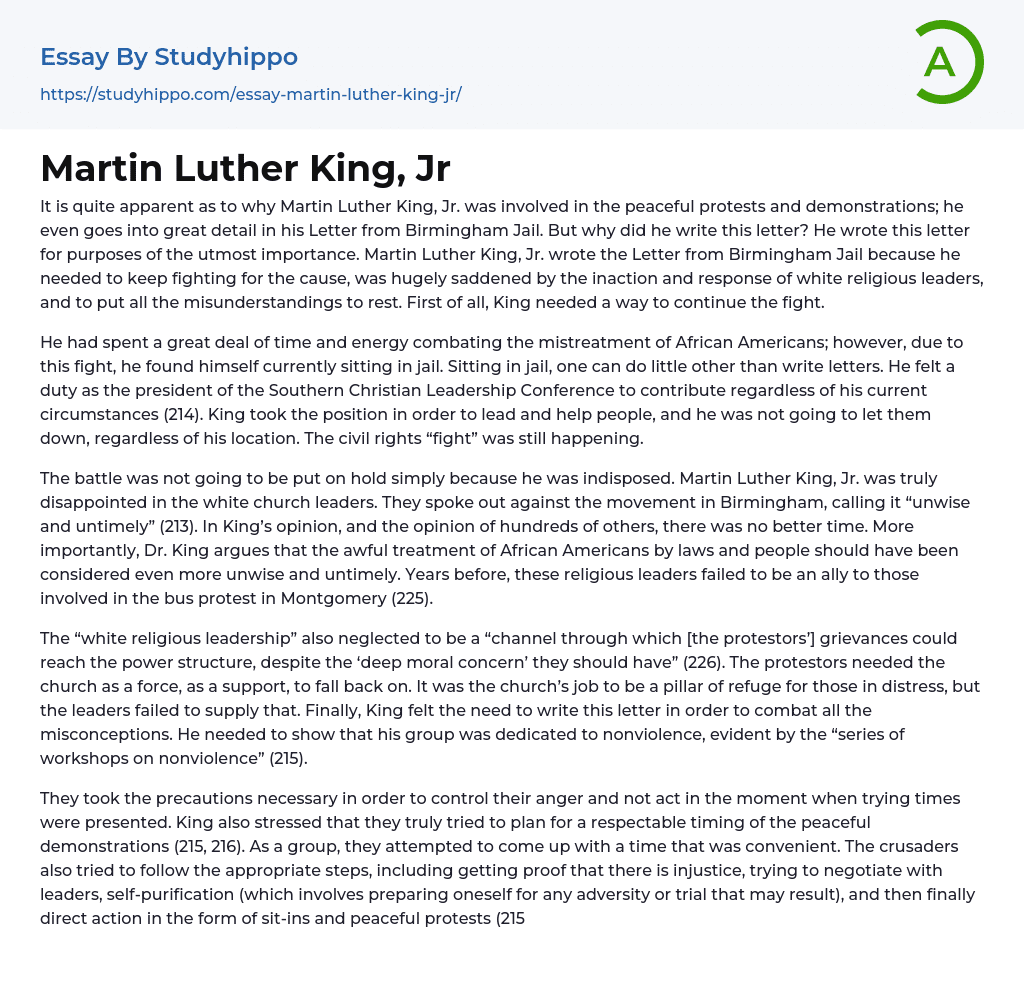Martin Luther King, Jr.'s involvement in nonviolent protests and demonstrations, as described in his Letter from Birmingham Jail, can be easily understood. Nevertheless, the letter was written with specific intentions. One of the main objectives of King's letter was to emphasize his unwavering determination to continue the struggle. He felt extremely disheartened by the lack of action and response from white religious leaders and aimed to clarify any misunderstandings and seek resolutions. Ultimately, King wrote the Letter from Birmingham Jail to ensure that the fight for justice would persist.
Although he dedicated a significant amount of time and effort to combat the mistreatment of African Americans, he ultimately found himself incarcerated. While in jail, his options were restricted to writing letters. Despite his current circumstances (214), as the president of the Sou
...thern Christian Leadership Conference, he felt compelled to continue making a difference. King took on his role with the purpose of guiding and supporting individuals, and he was resolute in not letting them down, regardless of his location. The fight for civil rights persisted.
While Martin Luther King, Jr. was not present, the battle persisted. The movement in Birmingham faced criticism from white church leaders who deemed it "unwise and untimely" (213). Like many others, King believed that there was no better time than the present to take action. Furthermore, Dr. King argued that the mistreatment of African Americans by both individuals and laws was even more ill-advised and poorly timed. These religious leaders had previously neglected to support those involved in the bus protest in Montgomery years ago (225).
The leaders of the "white religious leadership" failed to
serve as a conduit for the grievances of the protestors to reach the power structure, despite their moral obligation to do so (226). The protestors relied on the church for support and as a stronghold, but the leaders did not fulfill that role. Consequently, King wrote this letter to address misconceptions and demonstrate his group's commitment to nonviolence through a series of nonviolence workshops (215).
In order to control their anger and refrain from impulsive actions during challenging times, they took necessary precautions. King emphasized that they made sincere efforts to plan for an appropriate timing for the peaceful demonstrations (215, 216). Together, they tried to find a convenient time for their collective actions. The activists also followed a series of steps, including verifying the existence of injustice, attempting negotiations with leaders, engaging in self-purification (preparing themselves for potential trials and adversities), and ultimately resorting to direct action through sit-ins and nonviolent protests (215).
In conclusion, despite the bleakness of being in jail, Dr. Martin Luther King, Jr. recognized the importance of communicating with religious leaders who did not fully endorse the Civil Rights movements. He persisted in expressing his discontent with the clergy's attitudes and challenging the misconceptions held by many. All of Dr. King's actions were indispensable "because the goal of America is freedom" (227).
- Malala essays
- Activism essays
- Communism essays
- Conservatism essays
- Liberalism essays
- Marxism essays
- Nationalism essays
- Patriotism essays
- Policy essays
- Public Policy essays
- Social Contract essays
- Socialism essays
- Totalitarianism essays
- Abolitionism essays
- Adam Smith essays
- American History essays
- American Revolution essays
- Ancient Egypt essays
- Articles Of Confederation essays
- Atlantic Slave Trade essays
- Aztec essays
- Benjamin Franklin essays
- Civil Rights Act of 1964 essays
- Civil Rights Movement essays
- Civil war essays
- Cleopatra essays
- French And Indian War essays
- Gettysburg essays
- Great Depression essays
- Hurricane Katrina essays
- Industrial Revolution essays
- Jamestown essays
- Manifest Destiny essays
- Mccarthyism essays
- Patrick Henry essays
- Pearl Harbor essays
- Pocahontas essays
- Prohibition essays
- Pyramids essays
- Salem Witch Trials essays
- Slavery essays
- The New Deal essays
- Thirteen Colonies essays
- Westward Expansion essays
- Antisemitism essays
- Black History Month essays
- Black Lives Matter essays
- I Have a Dream essays
- Ku Klux Klan essays
- Malcolm X essays




